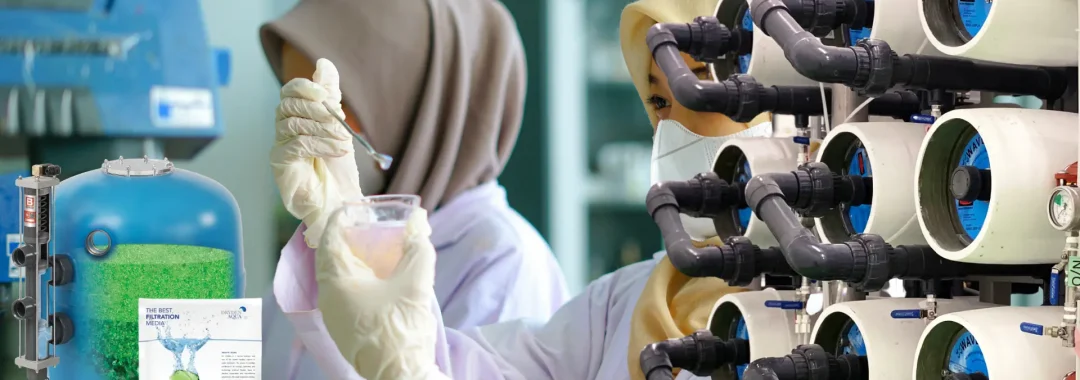Introduction — Why Laboratory Water Purification Systems Matter
A laboratory water purification system is essential to ensure the accuracy and reliability of every experiment, chemical analysis, or biological test. In research and testing environments, water quality directly affects experimental precision — even minor impurities can alter results.
Every advanced RO water purification setup for laboratories must meet strict ASTM and ISO purity standards to achieve reproducible outcomes and protect sensitive instruments.
A well-engineered laboratory water purification system combines Reverse Osmosis (RO) as the primary purification stage with polishing technologies like EDI, UV, and ultrafiltration as final refinement — ensuring the highest water purity grades required by modern laboratories.
🔗 Learn more about the official ASTM D1193 Standard for Reagent Water that defines Type I, II, and III laboratory water categories.
Understanding Reverse Osmosis in Laboratory Water Purification Systems
Reverse Osmosis (RO) serves as the foundation of a laboratory water purification system. Using a semi-permeable membrane, RO removes ions, particulates, microorganisms, and dissolved solids.
Typical RO systems in labs, such as Barnstead™ Pacific™ RO Water Purification Systems, are designed for high efficiency and precision.
At Gapura Liqua Solutions, we integrate advanced RO membranes and anti-scaling chemicals for RO systems to maintain consistent flow and prevent membrane fouling in industrial and laboratory applications.
The Role of Polishing in a Laboratory Water Purification System
Even after RO, trace ions, organic carbon, or endotoxins may remain. That’s where polishing comes in — the final step to achieve ultrapure water (ASTM Type I).
A well-designed RO + polishing chain includes advanced post-treatment components such as Activated Filter Media (AFM), UV oxidation, and ultrafiltration membranes.
📖 For reference, read Puretec’s High Purity Water Quality Standards Guide to understand laboratory water classifications and purity benchmarks.
Key Polishing Technologies for RO Laboratory Water Systems
a. Deionization (DI) in Lab Water Systems
Removes residual ions using ion-exchange resins — ideal for Type II or Type III lab water purification.
b. Electrodeionization (EDI) for High-Purity Lab Water
A continuous, chemical-free deionization method using electricity and membranes.
Learn more in this detailed Wikipedia article on Electrodeionization.
c. UV Sterilization in RO Laboratory Systems
UV lamps destroy microorganisms and reduce Total Organic Carbon (TOC), improving water stability and safety for sensitive testing environments.
d. Ultrafiltration (UF) for Laboratory Water Purification
Removes pyrogens, viruses, and macromolecules — ensuring ultrapure output suitable for biological, pharmaceutical, or analytical laboratories.
The Complete RO + Polishing Laboratory Water Purification Chain
An efficient laboratory water purification system follows a well-engineered sequence:
- Pre-treatment — sediment and carbon filtration using products like industrial filters.
- Reverse Osmosis (RO) — main desalination stage using RO membrane systems.
- Polishing Stage — DI, EDI, UV, or UF modules for Type I purity.
- Storage & Distribution — maintaining water purity during use.
📘 Examples of integrated laboratory systems:
- Avidity Science Puro-i III RO Water Purification System — combining RO + EDI in a compact lab unit.
- Sigma-Aldrich Lab Water Purification Systems — showing how global suppliers integrate polishing into modern lab systems.
Maintenance and Monitoring Best Practices for RO + Polishing Systems
Consistent performance of an RO + polishing system depends on proper maintenance:
- RO membrane cleaning and scaling prevention
- UV lamp and filter replacements
- Monitoring conductivity, resistivity, TOC, and flow rate
You can explore HANS Premium Water Filters for high-efficiency lab and industrial pre-filtration solutions that extend RO system life.
Applications of Laboratory Water Purification Systems in Research and Industry
Different labs have varying purity needs:
- Analytical chemistry labs require Type I water (TOC < 10 ppb).
- Clinical diagnostics need pyrogen-free water for sample accuracy.
- Pharmaceutical and biotech laboratories depend on EDI and UV polishing to maintain compliance and sterility.
The integration of RO + polishing is vital to every laboratory water purification system, ensuring reproducible results and regulatory compliance.
Environmental and Cost Considerations for Laboratory RO Systems
Modern RO systems are designed to minimize waste through high-recovery membranes and intelligent pressure control. Polishing stages such as Electrodeionization (EDI) further reduce chemical waste and energy use.
♻️ For sustainable practices, reuse RO reject water for cooling or cleaning — aligning with Gapura Liqua Solutions’ Total Water Solutions approach for environmentally responsible water management.
Conclusion — Building a Reliable Laboratory Water Purification System
Combining Reverse Osmosis with polishing technologies results in a robust, scalable, and sustainable laboratory water purification system.
By following ASTM purity standards and implementing scheduled maintenance, laboratories can achieve consistent, ultrapure water for all analytical and industrial applications.
Partner with PT Gapura Liqua Solutions — Indonesia’s trusted EPC company for integrated water treatment, RO membranes, and polishing solutions tailored for research and industry.
